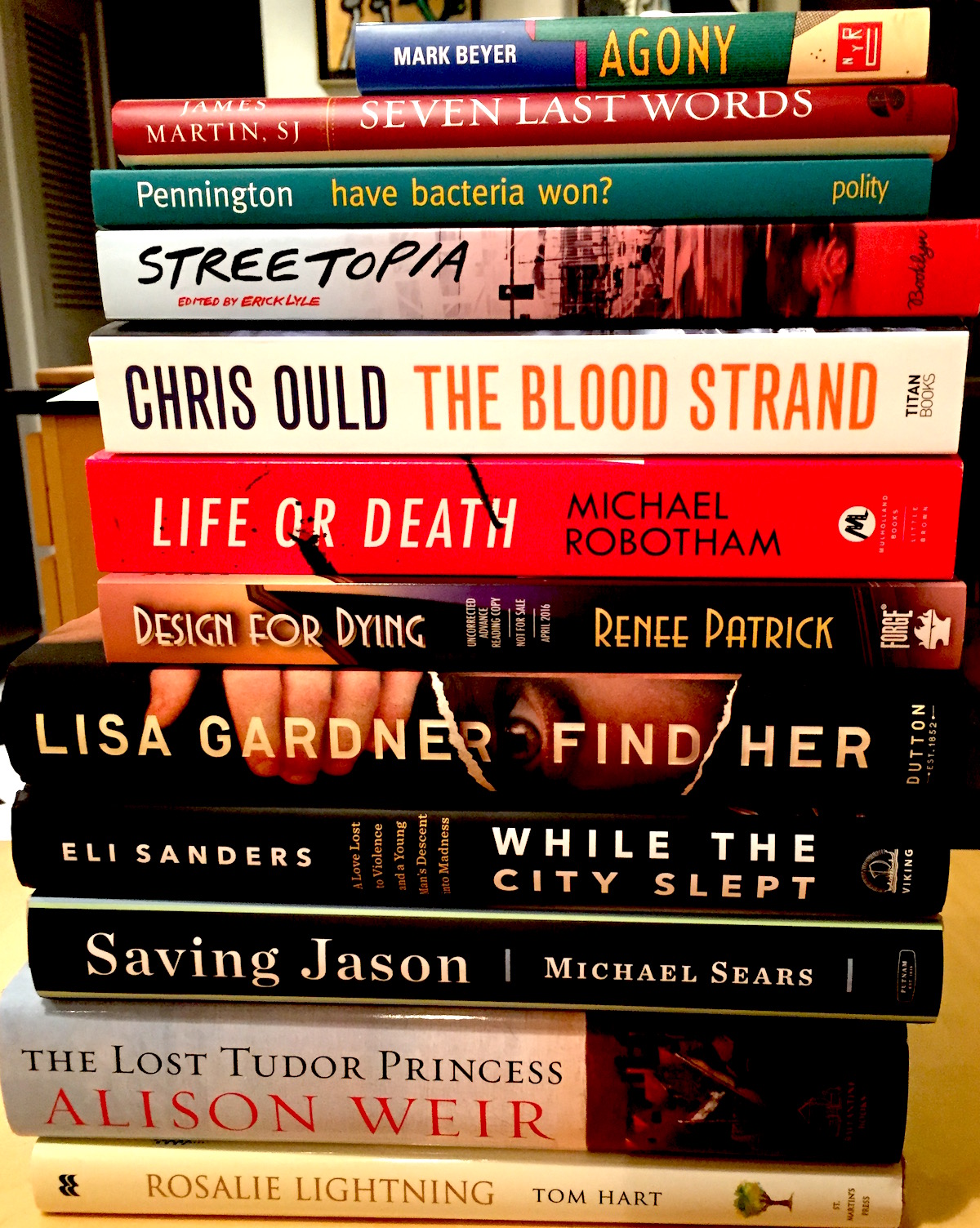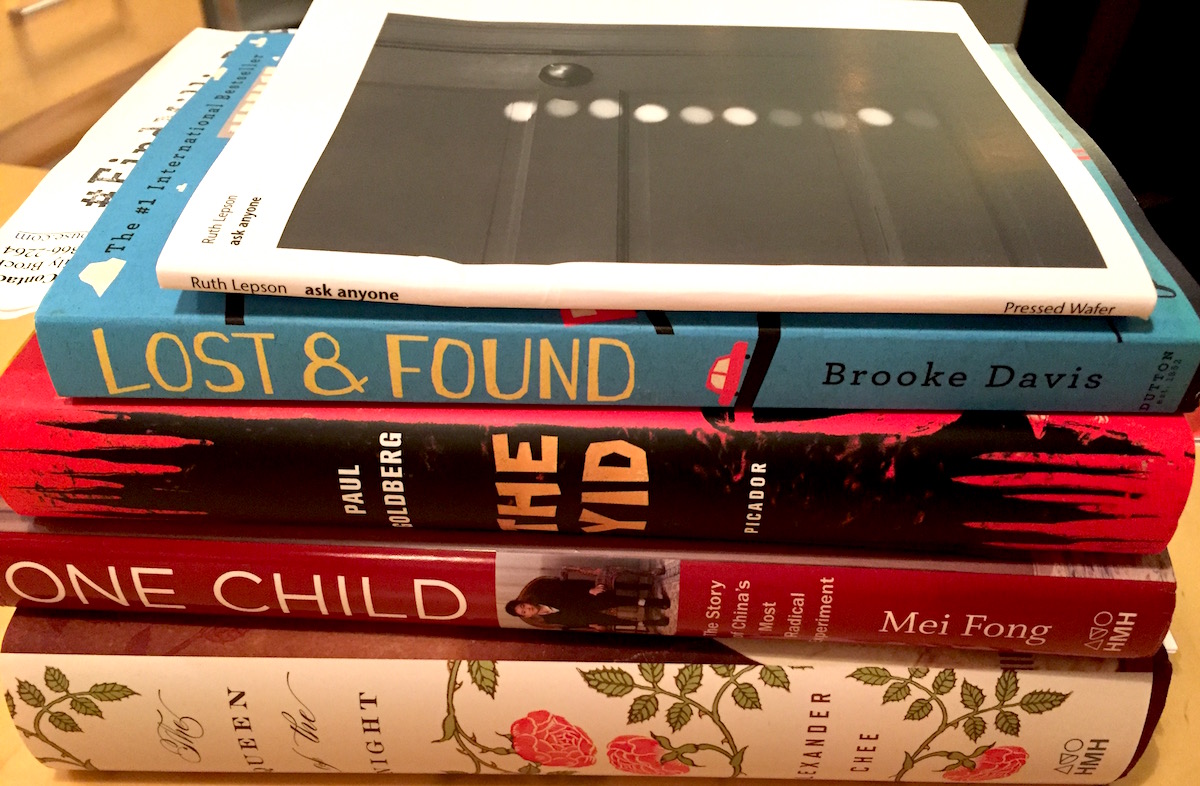Three Poems
disturbed bodies
(ours)
and on the other side
a moon
possibly…
watchingswitching pens there
subtle hope
& your tired body
tired
breathing hard…
to existMy minor violence
Toward the gazelle
Is unforgivable
Now making lists
Of the longing that will stay…
And the longing that
Will be fixed in images
Hatred splits us
But its necessity
Is like water
And love
“The idea of freedom might be too great a temptation for them to resist"
Published January 18, 2016, at 4:01pm
Scholastic took the rare step of withdrawing a controversial children's book from publication after outrage about the depiction of George Washington's slaves started to spread across social media. Was this the right thing to do? And what does this say about America's tendency to whitewash our history?
Dalya Alberge writes at The Guardian that a recently uncovered manuscript co-authored by Orson Welles reveals some truths about the friendship between Ernest Hemingway and Welles:
The manuscript, presented in a new study on Welles, reflects his disdain for a type of macho tourist frequently spotted in Spain when mass travel to the country took off in the 1960s. Intended to form the basis of of a love-triangle drama, the script features an American bullfighting aficionado, clearly inspired by Hemingway, as the lead character.
The draft, titled Crazy Weather, can be found at the University of Michigan. Speaking as someone who feels very uneasy about Hemingway's brand of machismo, I hope it gets published sometime soon.
Your Week in Readings: The best literary events from January 18 to January 24
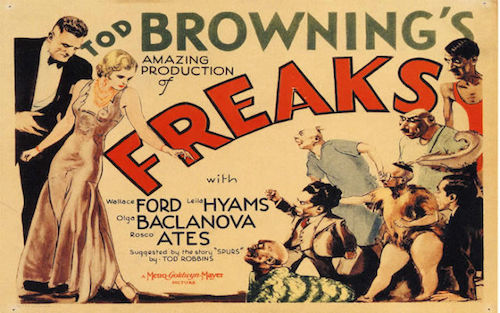
MONDAY Your week in readings begins at Seattle Center's Artists at Play Playground at 9 pm tonight. Seattle poet Arlo Smith reads as part of the Inumbrating Pinnacle reading series, which continues all week long, culminating on Saturday night. If you haven’t been to this playground, you should most definitely go just for the spectacle of it; it’s unbelievably cool.
TUESDAY Wage Slaves, the work-themed reading series featuring free donuts, happens tonight at the Hugo House. Tonight’s event is focused on women in the workplace, and readers include Sonya Lea, Storme Webber, Michelle Peñaloza, Tele Aadsen, and Jean Burnet. I bet there'll be a lot of jaw-dropping stories at this reading.
WEDNESDAY It’s back to the Hugo House with you to celebrate Seattle Arts and Lecture’s incredible Writers in the Schools program, which helps young people learn how to communicate through writing. Tonight, Seattle writing instructors with WitS will read new work. Readers include Samar Abulhassan, Daemond Arrindell, Emily Bedard, Aaron Counts, Laura Gamache, Clare Meeker, Peter Mountford, Sierra Nelson, Imani Sims and Greg Stump.
THURSDAY Good lord, it’s a three-night stand at the Hugo House this week! Washington publisher Two Sylvias Press presents authors reading from their new collections. Cecilia Woloch presents her chapbook Earth, which won the 2014 Two Sylvias Chapbook Prize, and Martha Silano reads the second, expanded version of her collection What The Truth Tastes Like.
FRIDAY The penultimate Inumbrating Pinnacle event happens at the Armory Monorail station at Seattle Center at 9 pm. Your readers are Seattle poetry stalwarts Jeremy Springsteed and Jeanne Morel. Why not take the Monorail from downtown to this one? You can pretend to be a resident of Seattle’s future, circa 1963.
SATURDAY Head to he central branch of the Seattle Public Library downtown for the first in an exciting new series put on by SPL called Page to Screen: Hear the Story, See the Film. It’s pretty much exactly what it sounds like: a reading of a short story, followed by a showing of the film adapted from that story. Today’s feature is Tod Browning’s incredibly creepy 1932 film Freaks — of “one of us! One of us!” fame —and a reading of Tod Robbins’s story “Spurs,” which inspired the film. It’s a neat idea, isn’t it? I’m excited to see how this works.
SUNDAY End your week with the excellent Monorail Reading Series at Fred Wildlife Refuge. Poets Raul Alvarez, Julie Carr, and Diana Khoi Nguyen read. With plenty of booze! I can't imagine a livelier way to close out the week.
The Sunday Post for January 17, 2016
How Could The Winds of Winter Be Published In Only Three Months?
If you're curious about how a book is made in our modern world, Tor took a detailed look. They were inspired by George R.R. Martin's letter to fans explaining why his manuscript for the next chapter in his Westeros saga wasn't going to be ready by deadline. He made the startling claim that if he had the manuscript done by the end of the year, the publishers were going to have the book ready by the end of March.
Book production, from the delivery of the manuscript to the book arriving on shelves, typically takes nine months to one year, so how is it that Bantam and Martin’s non-U.S. publishers could turn around an undoubtedly massive work like The Winds of Winter in less than three months? Learn about the typical book production process below, along with how unique marquee titles like The Winds of Winter can circumvent, compress, and alter that process.
The Reductive Seduction of Other People’s Problems
Why is it that young Americans seek to solve problems overseas instead of at home?
It’s intimidating to throw yourself into solving problems that you’ve grown up with and around. Most American kids, unless they’ve been raised in a highly sheltered environment, have some sense of how multi-faceted problems like mass incarceration really are. Choosing to work on that issue (one that many countries in the Global South handle far better than we do, by the way) means choosing to nurture a deep, motivating horror at what this country is doing via a long and humble journey of learning. It means studying sentencing reform. The privatization of prisons. Cutting-edge approaches already underway, like restorative justice and rehabilitation. And then synthesizing, from all that studying, a sense of what direction a solution lies in and steadfastly moving toward it.
Lifting the Veil on the New York Public Library’s Erotica Collection
Elaine Sciolino looks at the *** (triple-star) collection of the New York Public Library:
More recently, hundreds of works that make up the triple-star collection have been liberated from the restricted controls. An adult with a library card can simply fill out a request and peruse the material on the premises. (The library maintains a filter system to restrict access to erotic materials on the Internet.)
Fitting In: Tales of Supernatural Outsiders - Kickstarter Fund Project #2
Every week, the Seattle Review of Books backs a Kickstarter, and writes up why we picked that particular project. Read more about the project here. Suggest a project by writing to kickstarter at this domain, or by using our contact form.

What's the project this week?
Fitting In: Tales of Supernatural Outsiders. We've put $20 in as a non-reward backer
Who is the Creator?
What do they have to say about the project?
A collection of urban fantasy stories about supernatural entities in a world not made for them.
What caught your eye?
Local talent! Jeremy, and his wife Dawn Vogel, run the Mad Scientist Journal website, where they publish "a new story from the world of mad science every Monday." This is their fourth collection they've produced using Kickstarter.
I like the theme of outsiders, especially when mixed with the supernatural. Since Frankenstein, monster stories have been used as metaphors for feeling apart from other people. I like that they're tackling that straight on. And, as they say, "we are particularly interested in stories beyond the usual Western supernatural population. Vampires and werewolves are fine, but we'd really love to also see stories tapping into African and Asian myths."
You can get a copy of the book as cheap as $15, which is a nice price for helping bring something like this to life.
Why should I back it?
Support local small publishers! Genre stuff like this often gets put on the side table, if you're not in the fan base, but there's a particular pleasure in cracking a good themed anthology. You owe yourself the experience, if you never have — you may think you know what you're going to get, but there are always surprises.
Plus, work like this is a labor of love. I would guess that Jeremy and Dawn are putting these projects out because they love them, they want to give back to their community, and because they're filling a gap where they wanted to read deeply where other people weren't publishing. I hazard to say that nobody's getting rich, here. It's about bringing things they love to fruition.
How's the project doing?
At 33 days to go, and only about 11% there. But, based on their track record, I imagine they'll make the mark
Do they have a video?
Kickstarter Fund Stats
- Projects backed: 2
- Funds pledged: $40
- Funds collected: $0
- Unsuccessful pledges: 0
- Fund balance: $1000
The music is terrible, the presentation glib, and the $400 only accounts for mininum-wage labor, not materials (like the cost of the animals slaughtered).
But, this video is valuable for showing just what goes into making the materials of a very rustic book. Making a refined book is only easy due to the scale of industry.
Watching this reminds me that books are a technology, and like any technology, the methods of production have been perfected over time, until books became so ubiquitous that the process of making them completely dissapeared, and all we are left to think about is the content inside of them.
The Help Desk: My bookish friend drinks too much. Can books save him?
Every Friday, Cienna Madrid offers solutions to life’s most vexing literary problems. Do you need a book recommendation to send your worst cousin on her birthday? Is it okay to read erotica on public transit? Cienna can help. Send your questions to advice@seattlereviewofbooks.com.
Dear Cienna,
Have you ever tried to get somebody to change by offering a book that you think might affect them? I have a friend who is drinking himself to death. He listens to books, but not people. Books have changed me, maybe one would change him. Any ideas?
Seth in Georgetown
Dear Seth,
As a teenager I received at least seven copies of How to Make Friends and Influence People from a bouquet of well-intentioned dickheads. I read the damn thing at least twice. It did not make me better at making friends, or even better at making eye contact with strangers. It did nothing but make me resent the fact that I was too old to be cute and too young to drink.
That said, I’d caution you about gifting a book with the hope of changing someone. In my view, books are not topical salves prescribed to fix personal flaws, they are the simplest form of love letter – you give them to people you love because you believe their content will resonate with them on an emotional and intellectual level. Whatever personal change occurs because of that connection is secondary.
Fortunately for you, I have a ton of heavy drinkers in my life and I love at least half of them. Here are three books I’ve read about addiction: Drinking, A Love Story; The Night of the Gun; Dry. I gave the first two as gifts to friends (I didn’t love Dry, to be honest, but I know quite a few people who did). The books did not change my friends’ drinking habits at all. But it did create an avenue to talk about addiction and we’ve had a few good conversations about alcoholism since then. Usually while drinking.
So: I recommend you read those books and see if any of them remind you of your friend. If you have the time and interest, you should also read this fascinating article published last year in The Atlantic that critically challenges the efficacy of AA.
More importantly, I’d like to point out that I have lots of friends now, even if most of them are only half sober.
Suck it, Dale Carnegie.
This morning, Pioneer Square's Seattle Mystery Bookshop launched a GoFundMe campaign "to make sure the rent is completely paid off, all our suppliers are happy, and to restore missing titles and depleted series to our shelves." Their goal is to raise $50,000. Rewards for the campaign include signed first editions, a noirish 1974 Michael Garmin sculpture, tote bags, and coffee cups.
If you'd like to learn more about what makes Seattle Mystery Bookshop so great, we have a whole series of pieces explaining just that — they were our Bookstore of the Month back in September. We explained the unique pleasures of the shop, their amazing propensity for finding just the right book for just the right person, the way they seduce non-mystery readers into reading mysteries, and we ran some brilliant recommendations from their booksellers.
If crowd-funding isn't your thing, stop by Seattle Mystery Bookshop — they're at 117 Cherry St — and pick up a few titles. Your purchase will be much appreciated. Here's hoping they'll stick around to introduce readers to the great mysteries for many decades to come.
Ghost Tokens: Inumbrating Pinnacle is a seven-day literary event in Seattle Center
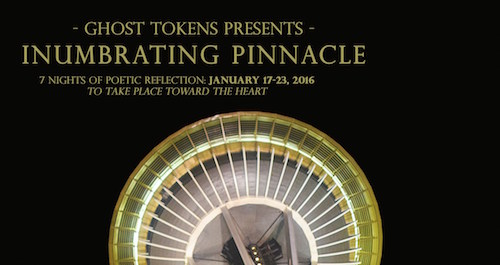
Originally from Gorham, Maine — coincidentally, one town over from my native Buxton — poet Greg Bem moved to Seattle and immediately started building a community of artists and writers. He’s thrown a bunch of events all around town (you’ll read more about those in a second) and his passion for intelligent, challenging work has improved the quality of discourse in Seattle’s art scene. Bem’s newest project is a weeklong series of free readings at Seattle Center titled Ghost Tokens: Inumbrating Pinnacle. Starting Sunday and continuing every night for seven days, at 9 pm a poet will read at a different Seattle Center location. (You can find a full listing of readers on the official site, but names include Paul Nelson, Jeremy Springsteed, and Justine Chan, and locations include the Artists at Play Playground and the Monorail Station.) Bem kindly agreed to answer a few questions about the project.
You’ve produced or co-produced a number of great events—lit crawls in Greenwood, the Breadline reading series on Capitol Hill—but it seems like you stopped for a while there. Why are you back on the event horse?
Back in 2013, a graduate student studying to become a librarian, I had the opportunity to leave Seattle and go study and work abroad, in Phnom Penh. It was an opportunity I could not pass up, and so I followed that path. As an artist I discovered exponential growth through countless new cultures and countless new experiences. Cambodian art and contemporary literature (and Southeast Asian art, generally) inspired my personal writing, and I was also connected to a completely fresh community of voices (as well as voices outside the community). Though I wasn't throwing lit crawls on the mean streets of the Pearl of Asia, I did have a few opportunities to curate events, specifically with Java Arts. Our City Festival was perhaps the most enjoyable event I collaborated on, which featured a plethora of poets reading from a balcony of a decaying French colonial mansion.
That was in 2013 and 2014 (the three month internship turned into four jobs and a desire to live out there longer — as most who go with short-term intentions end up choosing to do). I was back in Seattle for 3/4 of a year and that was the closing of the Breadline. Everything was up in the air. Alex Bleecker ended up choosing to move to Cambodia to teach and so we (Jeremy Springsteed, Alex, and myself) needed to find some kind of resolution with a series that was dear to my heart, but that was no longer as sustainable or as inspiring to the three of us. So we capped it out with an anthology that was backed by our features and the literary arts supporters in Seattle, and we released it at the last Breadline. 2015 also saw the beginning of what will hopefully continue a couple times a year — the Rainier Valley Lit Crawl, which I helped organize with Raanan David, Jeanne Morel, and Babara Erwine — two instances, one in the Winter and one in the Fall. There was no summer in Seattle for me as I went back Cambodia to do more library work and run a writing workshop for the Nou Hach Literary Association. I'm bouncing around, but you get the idea — everything has been all over the place.
Now I'm back in Seattle and energized and inspired and I've been meaning to be a bit more mindful and aware of what I'm doing with myself in 2016. I'm looking to collaborate. I have a very invigorating girlfriend, Scherezade Siobhan, who has been supporting me, and we're constantly throwing ideas for conceptual events and activities around. There are a lot of people running around with ideas, too, and some are pulling them off, but some, as has always been the case, need the legwork done for them, need the space, the opportunity. In general, though, I'm doing what I've always found to come naturally here: experimenting. I love the other folks who organize events in Seattle (you know who you are!) and love that almost every night of the week there's something going on, but I often find myself disappointed with the format or venue or intended experience for readings. I tend to look over event listings with a glazed, "that's it?" look. But I'm thankful. Without the average, granola readings, I wouldn't be inspired to do these kind of cultural bellyflops.
Can you talk about some of the people you chose to read in Ghost Tokens, and what made them right for this?
I never invite people who don't interest me — whose work doesn't interest me — for a specific event. With this event in particular, I invited quite a number of people, because of how open and incredibly exciting the theme of this reading is. In the end, who did I choose to read? Most importantly, these are folks who responded to my invitation. I tend to throw out multiple invitations at the same time and wait and see who positively responds. Sometimes artists are not available. Sometimes themes/topics aren't inspiring or interesting. Sometimes other projects are taking over. Scheduling conflicts, and so on. Some people simply don't want to stand outside in the freezing cold January evenings doing some conceptual reading. I get that. It's not for them. But there are people who are willing to take that risk, and are willing to participate in a cultural activity that's engaging ideas in settings/environments/venues. The parameters are fairly unique. If someone's excited to participate with all of that — then they're "right for this." That said, we won't know how it goes until it goes, as is always the case.
And what inspired you to choose Seattle Center? The location started as sort of the central home for Seattle’s hope, back in the World’s Fair. In the 80s and 90s, it fell into disrepair and the city started to take it for granted. Now, with the expansion of rich-person ego projects like Chihuly Museum and the EMP, it’s almost become a symbol for Seattle’s present state of corporatization and gentrification. Are the events going to reflect Seattle Center’s history and comment on it, or are they more about the city, or is the geography of it just a coincidence?
If someone had asked me to help with an event at Seattle Center, centered around the Space Needle, five years ago, I would have laughed and told them the idea is corny. So maybe I'm just a corny aging Seattle writer now. Maybe. I actually think Seattle Center as a symbol is incredibly sophisticated now more than ever — or at least since it was built/installed. For a lot of people — those visiting from other parts of the region, those tourists from Japan or China or back East or whatever — Seattle Center is still a shining cultural identifier. It happens almost daily: someone I know who doesn't live in Seattle tells me, "Your city is funky. It has the Space Needle. And that weird music museum."
But now Seattle Center is becoming aged in its own right, and that's the pivotal point. That's why it's now interesting to me. All that gentrification and ultra-fast development we didn't want to affect South Lake Union and Capitol Hill five years ago--it already happened. Yeah, the cranes are still there (I love cranes, by the way), and there will be more growth, but the next phase is already long begun. Things have already changed. That's really what I personally want out of this reading series--to actually hear people address the current Seattle like it's current — not like it's about to happen. And what better place to see Seattle than from its now-timeless core?
As for the readings themselves, I have no idea what to expect. Part of the Ghost Tokens series has always been about the unexpected and the excitement of the unknown. The first "set" of Ghost Tokens experiences brought out a few artists to a random park in South Seattle and there were only five or so people in the audience. It was great seeing how the artists engaged the event under the parameters of place that were provided. Inumbrating Pinnacle will do the same, but takes the series to the next level by opening the door to comment on directly on one aspect of our city.
What do you think makes a great literary event?
Jesus — I think any response I provide to this question is going to come back and bite me in the ass in a week or something. I'll answer anyway. First and foremost it's the spirit of it. I think those who are performing and those who are in the audience need to believe in the event itself. They need to participate for the sake of the event over the sake of the performers or the audience. It's one big experience, and if everyone's on board, then the most beautiful things can happen. There were Breadline moments when Jason Conger had every single person in Vermillion spouting sound poetry. That's beautiful. That's a great literary event.
There was this one Ghost Tokens at the Hat and Boots Park in Georgetown where Lydia Swartz required every audience member to hold flashlights on different areas in the playground as she read some of the most personal writing I've ever heard read in public. That was a great literary event. Someone (maybe Tara Atkinson?) asked me during APRIL's first lit crawl to ride in a little red wagon down Pike Street on Capitol Hill. That was a great literary event.
Cheap Wine and Poetry hosted by Brian McGuigan and me as an after-party for Paul Nelson's organized Cascadia Poetry Festival, which had twenty or so readers reading poetry in a Columbia City gymnasium, and then everybody drank all the beer from all the kegs, and Brian nearly got in a fight with another poet. Great literary event. These are moments. These are experiences. These are, most importantly, memories. They aren't just another stop on the book tour of so and so. They aren't stale or dead or devoid of culture. They exhibit time and place with specific participating actors, and everyone who shows up can join in. Participate. Fall in love with the ideas that are born there.
Others to fall in love with: Lo Fi's Not to Scale Festivals, the Duwamish Revealed events from last year.
The event has two very interesting names: Ghost Tokens and then Inumbrating Pinnacle. It evokes, to me, the late, lamented Fun Forest, which was home to a collection of games that required tokens, and also the Space Needle, which certainly could be interpreted as a pinnacle whose shadow spreads quite a distance. Is my reading right? Or am I just blowing smoke?
It's cool that you've evoked Fun Forest out of Ghost Tokens. Ghost Tokens is a term that came to me in 2012 or 2013, kind of randomly, or channeled through the radio maybe (I was reading Jack Spicer at the time, so perhaps!), and I used it as a gate to exploring outdoor spaces and history in South Seattle. It was always the International District and South. Mainly because I've always lived in South Seattle and, despite the gentrification in Columbia City, feel like this region doesn't get a lot of attention, and thus is a great canvas for exploration and creativity. Anyway, since the generation of the title the series has become more aware of itself, of the ghosts, of spaces previously created by really amazing people (have you been to the trail on Hitt's Hill? — it's incredible), and the series channels that energy. I guess there was too much in common with my idea for this sequence of events at Seattle Center to not use the Ghost Tokens title. I still have five more locations for Ghost Tokens in South Seattle though — and hope to accomplish those events before the end of 2016.
As for Inumbrating Pinnacle, it is how you've described it. And perhaps calling the event that name loads the event up with meaning and diffuses the openness to the readers. I don't know. We'll have to wait and see, but one thing is for certain: development is a shadow over the city. It might not be terrible, but it does cover, cloud, mask, reduce that which is clear and meaningful to many people — at least in the short run. We'll see how everyone else interprets the name and theme when the event goes down.
Breadline has cast a long shadow in Seattle literature; I hear a lot of event organizers say that they hope to achieve some of Breadline’s energy and curiosity. What do you think people will take from Ghost Tokens: Inumbrating Pinnacle?
Breadline had regularity and diversity. Sure, it was three white guys running it, but we were constantly trying to expand it and make it new, make it new, make it new. And Jeremy, Alex, and I had such varied interests and our own little communities that it worked. I think that's why APRIL works too — especially now that it can be described as a "regular event." Lit Crawl (the official one) also has these qualities, though in my opinion it's too big for itself to achieve the same level of intimacy as APRIL and Breadline — and Red Sky back before I moved here, which apparently had a very amazing "vibe" to it. Anyway, I would love to see other people throw together something similarly arousing and explosive and unique on a regular basis like the Breadline. It'll happen soon enough!
As with all my events, as I said above, I hope people simply enjoy the experience of the event. The readers are all strong and experienced and the spaces are all unique (come on--we could all stand in Sonic Bloom all day and enjoy ourselves!) so it's just a matter of attending and feeling the moment. That sounds like new age nonsense, but that's how these things work, I've noticed: zero in, focus, enjoy, and remember. Also, hopefully people will have their paradigms of what makes an event an "event" shift. I doubt anyone other than myself will attend every single night next week, but the short duration of each event (no more than 30 minutes) for seven nights in a row is guaranteed to raise a bunch of questions of what defines a literary event. I think it goes along with how we engage in "living" in the city, but also will be nicely connected with how we engage life in and out of our smart phones.
Portrait Gallery: Red Pine
Each week, Christine Marie Larsen creates a portrait of a new author for us. Have any favorites you’d love to see immortalized? Let us know
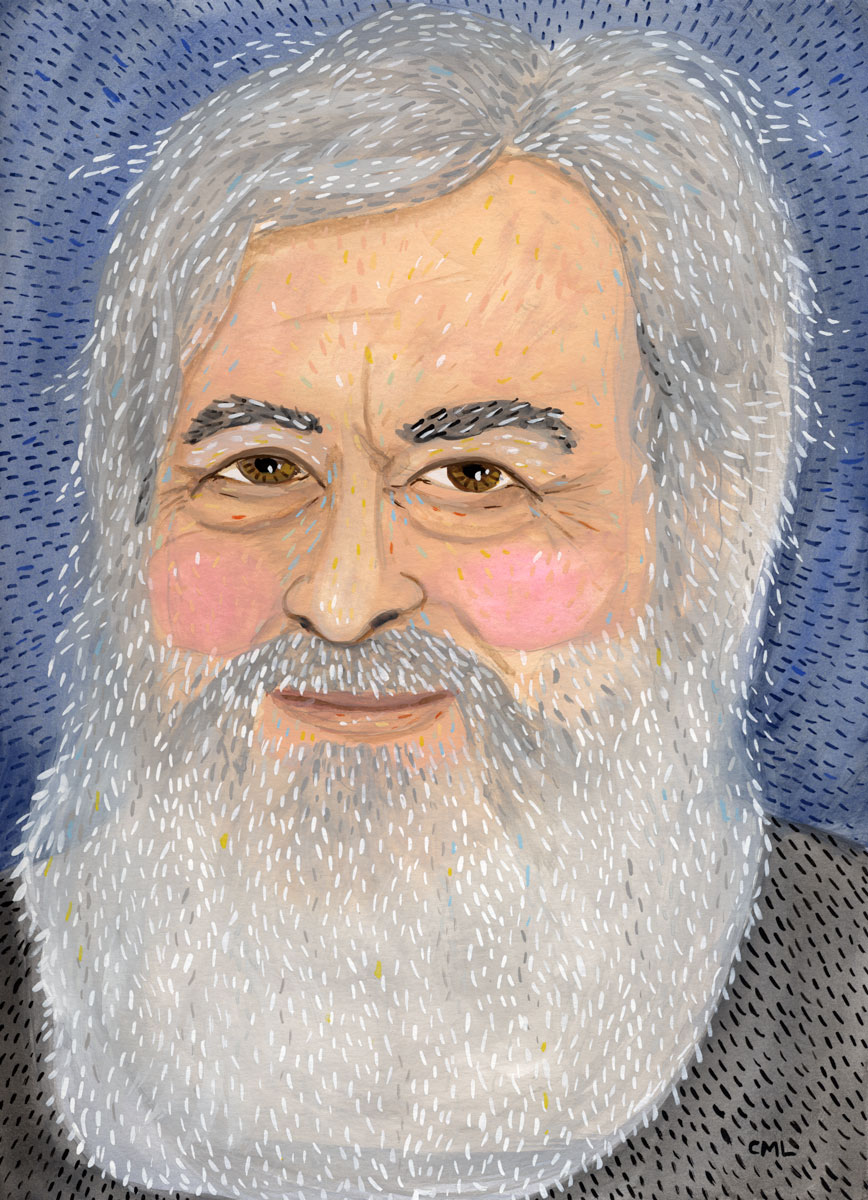
Red Pine (also known as Bill Porter) will be appearing Saturday at The Elliott Bay Book Company, reading from his latest book Finding Them Gone: Visiting China’s Poets of the Past.
Now that Mein Kampf is back in the headlines — thanks a lot, Germany — Adam Gopnik reviews the book for The New Yorker.
...the striking thing about the text as a text is that it is not so much diabolical or sinister as creepy. It is the last book in the world that you would expect a nascent Fascist dictator to write... Hitler, whom we suspect of being an embittered, envious, traumatized loser, presents himself as . . . an embittered, envious, traumatized loser.
This is a very good book review and you should read the whole thing.
Thursday Comics Hangover: Secret War is over (if you want it)
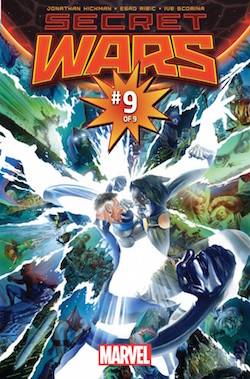
You can't really explain Secret Wars to someone who has no prior experience with Marvel Comics. Here's a rough attempt at describing the premise: Doctor Doom has willed himself to godhood, presiding over a patchwork planet constructed from dozens of alternate universes featuring Marvel's heroes in all sorts of strange combinations — cowboy Captain America, 1990s cartoon X-Men, Thor cops, and so on. On its face, it's just an excuse to dress up the old familiar superheroes in new costumes for a while. But in its execution, Secret Wars read like a Game of Thrones-style saga that investigated the very idea of superhero comics.
Hickman's script is dense and witty and, to someone who has never read a superhero comic before, likely impenetrable. But the impenetrability is a feature, not a bug. Just as TV shows like The Sopranos and Breaking Bad rewarded viewers who watched the whole series from beginning to end, all of Hickman's Marvel work since 2009 has proven itself to be a single text with a beginning, a middle, and a conclusive end.
And so how is the end? It comes together better than I ever would have expected, building to a conclusion that is satisfing and relentlessly optimistic. What Hickman has built in Secret Wars #9 is a superhero comic about the joy and fun of superhero comics, a refutation of decades of relentlessly "realistic" (by which I mean depressing and dark) superhero comics. Rather than destroying legacies and killing characters, Hickman revels in the act of eternal creation. For the never-ending story that is monthly superhero comics, it's a fitting climax.
Ribic proved to be the perfect partner for Hickman's Marvel swan song. His heroes look heroic — even with his painterly style, grown men in spandex don't seem silly at all — and his rendering of Hickman's cosmic concepts feel at once alien and familiar. One page, featuring Mr. Fantastic and Doctor Doom's faces split into dozens of tiny panels and interspersed, mosaic-like, captures the theme of the series: over the course of decades, every superhero and super villain contains multitudes of interpretations and renderings. Those many selves, from the cartoonish 1960s to the realistic 1970s to the gritty 1980s, may seem contradictory and fractured, but if you stand far enough back and take the whole tableau in, you can see that the purity of the original concept still shines through. These are sturdy ideas, Hickman and Ribic are saying, and they will keep spinning out into the future in ways that will surprise us.
The Arkansas-born poet who published with Copper Canyon Press died unexpectedly yesterday. She was a MacArthur "Genius" award winner and a giant on the American poetry scene. You can find some remembrances of her life and work by Max Brantley and Rich Smith, and there will undoubtedly be more in the days and weeks ahead.
For right now, I'd like to send your attention to a recording of Wright reading her own poem "Everything Good Between Men and Women" at the Poetry Foundation. It's a loud, lively, even raucous poem that starts with a bang (the title flows dircectly into the opening lines, "has been written in mud and butter/and barbecue sauce") and concludes with a demand for the reader to "Call it a night. O soul. Flow on. Instead." That's a powerful demand from a poet to her audience, and tonight it feels like something more: sad, encouraging, raw. It feels like an invocation, a demand, and a love letter all at once.
Remember when I told you that Mein Kampf was about to be published in Germany again for the first time since World War II? Yeah, it sold out in less than a week. This is not the ending to this story that I was hoping for.
(Vaguely related: one time back in my bookselling days, a customer tried to return a copy of Mein Kampf because it was an "inferior text." He was upset that the introduction was written by a Jewish person. I just stared at him for a bit and then walked away.)
Book News Roundup: Write your way to a free Seattle apartment
An anonymous Seattle apartment building owner is running an essay contest. The winner gets to live rent-free in a "clean, comfortable place" in Queen Anne or Ballard for a year. The essays are supposed to respond to the question "How would a free apartment for one year help you reach your goals in 10 years?" in 350 words or less. You can't solve gentrification with a writing contest, but at least the odds are better than Powerball.
Cascadia College in Bothell is hosting a six-week course called "Innovative Cascadian Poetry." The course "delves into the geography and poetry of the Cascadia bioregion, exploring the area’s physical landscape, its cultural roots, and the innovative poetry produced there." It begins on January 25th.

Jeff VanderMeer's new short story is titled "Jeb Bush Is Sinking," it's published at Electric Literature, and it's fantastic, especially if you're the sort of person who has really enjoyed watching Jeb Bush squirm over the last few months.
Amazon is merging its original book social media site Shelfari with its other book social media site GoodReads, and at least one Shelfari user is very upset about it.
The January issue of The White Review — featuring works in translation — is available online. If you're looking for somwehwere to start, I very much enjoyed this weird and wonderful short story titled "Dimples."
This week's Seattle Weekly has a profile of Twice Sold Tales owner Jamie Lutton. The longtime Capitol Hill used bookstore owner is, according to reporter Casey Jaywork, facing two crises at once: business at her store is in decline, and her kidneys are failing — she's "maybe a year from peritoneal dialysis." Go read the whole piece, and please visit Twice Sold Tales this week.
The many sides of Push/Pull, our Bookstore of the Month
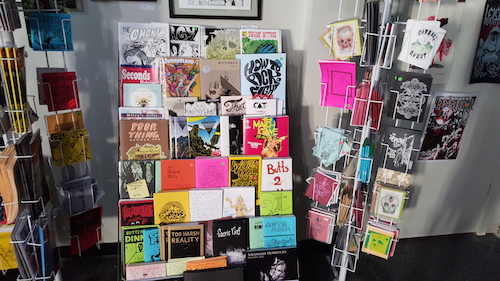
Last week, I erroneously referred to this month’s Bookstore of the Month as Push/Pull Gallery. That's my mistake; it’s just Push/Pull. There’s a reason why founder Maxx Follis decided to drop the descriptors from the name — it’s because the space performs many functions at the same time. Yes, it’s a gallery. And yes, it’s a bookstore providing one of the biggest selections of small press comics in the city. But it’s a lot more than that. Push/Pull is…
A library: Right at the front of Push/Pull is a small library of comics and zines, available for anyone to come and read for free whenever they like.
A reading space: When you walk in the door at Push/Pull, you’ll find a couch next to a (fireless) fireplace. It’s a cozy place to sit and browse through the books in the library.
A pinball arcade: Next to the couch are two pinball machines. One of the pinball machines is roller-derby themed, and the other is skateboard-themed. Both games have amazing 1980s art featuring people in very tight pants acting way too sexily. A change machine is available for those who like to spend hours at the flippers.
An art gallery: Push/Pull is home to themed shows by local illustrators, cartoonists, and other artists. The exhibit right now is titled Urban Divination, and it featured tarot-themed work, some of which is delightfully porny. An upcoming exhibit will be mad-science themed.
An event space: In the two months since it’s opened, two local cartoonists have rented out Push/Pull to host their comic release parties, with bands and booze and autographs.
A community for artists: Push/Pull is hosting art classes, comics classes, and a series of nights where cartoonists will attempt to write and illustrate complete comics in 6, 12, and 18 hours in preparation for next fall’s 24 Hour Comic Day.
A comic store: With about 70 titles available, Push/Pull is on the way to having the biggest collection of local indie comics in the city. There’s a strong focus on local cartoonists, but Portland and Santa Fe are also represented, among other cities.
A gift shop: Push/Pull also sells greeting cards, patches, buttons, t-shirts, hoodies, stickers, and other small items, all of which are handmade by local artists. If you’re looking for a Rod Serling t-shirt or a Mr. T birthday card, you’re probably in the right place.
Artist space: For $25 a day, or less per week, artists can rent a large easel or one of two desks in a separate room in the back of the space. Artists also have access to a kitchen, a bathroom, free wifi, a large treasure trove of art supplies, and “usually coffee and tea.”
Obviously, Push/Pull Library, Reading Space, Pinball Arcade, Gallery, Event Space, Community, Comic Store, Gift Shop, and Artist Space is a bit too unwieldy, so Follis instead opted to go with just Push/Pull. Probably a wise choice.
